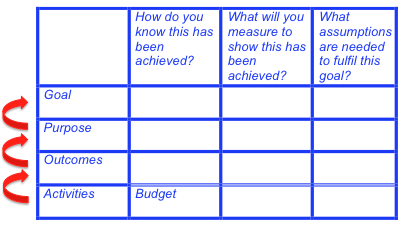
Planning ministry is all about having a vision to produce ‘Oaks of righteousness’, people who are currently poor or disadvantaged but who can be equipped practically and, with the transforming impact of the gospel, can become all that God intended.
So far we have looked at two steps in the planning process. The Problem Tree helps us identify the various components contributing to the needs to be addressed through our proposed ministry. The Solution Tree seeks to suggest ways of reversing those problems.
Logframe
We shall now look at the Logical Framework for planning, usually called a Logframe. This is a technique taken from the development world which is widely used for defining programmes, particularly when applying for funds from major donors. It inevitably has both strengths and weaknesses. However, in my opinion the strengths far outweigh the weaknesses, especially if it is used with an ear open to the Holy Spirit – something that most in the development world are sadly ignorant about.
I will share my version of this as, from a Church perspective, there are some adjustments I recommend, particularly that ministry tends to be defined ‘bottom up’ based on gifting within the church rather than ‘top down’, when governments and large NGOs have a national or sectoral strategy and then seek ways of implementing it. Church ministry tends to be more ‘grass roots’ than the larger organisations.
Key elements of the Logframe
The Logframe is a 4×4 grid. The four columns represent
1. Goals and aims
2. What evidence you expect to see that shows those goals are being achieved.
3. What you will measure or otherwise demonstrate that that evidence is trustworthy.
4. Any conditions that, if they are not met (e.g. riot and flood), will prevent these goals being achieved.
The four rows successively build up the big picture from the detail of what actual activities you will be carrying out in order to achieve your particular goals within the larger context e.g. train teachers of primary schools as a contribution to raising the standard of education in a particular nation.
Each level (row) contributes to the one above and so there is an overall flow through the chart which will become clear as we proceed. But the flow diagram will look something like this when we have completed the exercise.

Next time we shall begin to look at how to define the goals and aims in the first column to see how our ministry will contribute to the larger need.
